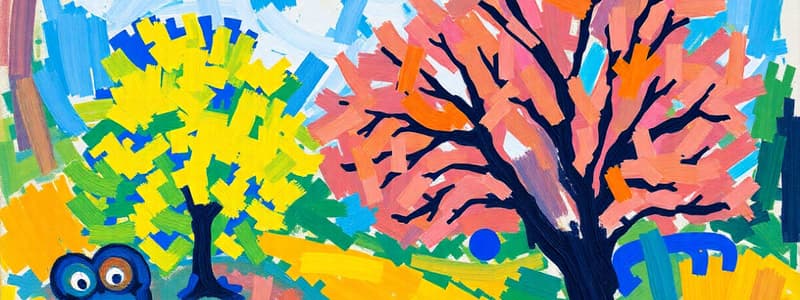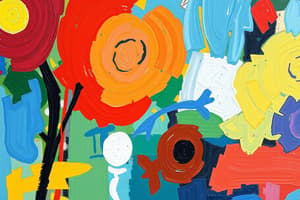Podcast
Questions and Answers
What movement aimed to merge consciousness with unconsciousness to create a new reality?
What movement aimed to merge consciousness with unconsciousness to create a new reality?
- Expressionism
- Surrealism (correct)
- Impressionism
- Cubism
Which of the following is not one of the six main kinds of subject in art as mentioned?
Which of the following is not one of the six main kinds of subject in art as mentioned?
- Performance Art (correct)
- Still Life
- Portraiture
- Abstract
In expressionist art, how is color typically characterized?
In expressionist art, how is color typically characterized?
- Naturalistic and subdued
- Vibrant and pastel
- Highly intense and non-naturalistic (correct)
- Monochromatic and minimalist
Which subject refers to a scenic representation of nature's elements like mountains and rivers?
Which subject refers to a scenic representation of nature's elements like mountains and rivers?
What characterizes factual meaning in art?
What characterizes factual meaning in art?
André Breton is best known for which of the following?
André Breton is best known for which of the following?
Which of the following best describes the concept of 'day of the dead' in art?
Which of the following best describes the concept of 'day of the dead' in art?
What does conventional meaning in art refer to?
What does conventional meaning in art refer to?
Which artist is not considered part of the Impressionist movement?
Which artist is not considered part of the Impressionist movement?
What is a defining characteristic of Fauvism?
What is a defining characteristic of Fauvism?
What distinguishes photorealism from other art styles?
What distinguishes photorealism from other art styles?
What distinguishes Abstract art from Impressionism?
What distinguishes Abstract art from Impressionism?
What does Photorealism predominantly rely on?
What does Photorealism predominantly rely on?
What is a key characteristic of realism in art?
What is a key characteristic of realism in art?
Which artistic movement emphasized speed and technology?
Which artistic movement emphasized speed and technology?
Which description best captures the essence of beauty in art?
Which description best captures the essence of beauty in art?
How is abstract art typically perceived?
How is abstract art typically perceived?
Which of the following statements about Abstraction is true?
Which of the following statements about Abstraction is true?
What defines constructivism as an art movement?
What defines constructivism as an art movement?
Which artist is associated with the early twentieth-century Fauvist movement?
Which artist is associated with the early twentieth-century Fauvist movement?
Which of the following best describes abstract art?
Which of the following best describes abstract art?
Photorealism emerged as a reaction to which art movement?
Photorealism emerged as a reaction to which art movement?
What are the typical features of photorealist painting?
What are the typical features of photorealist painting?
Who was a leading figure in the realism art movement?
Who was a leading figure in the realism art movement?
What is the significance of form in a piece of art?
What is the significance of form in a piece of art?
Which statement accurately describes primary colors?
Which statement accurately describes primary colors?
How is a line primarily defined in art?
How is a line primarily defined in art?
What distinguishes an artist from an artisan?
What distinguishes an artist from an artisan?
Which type of shape is known for having an outline or boundary in art?
Which type of shape is known for having an outline or boundary in art?
What role does space play in art?
What role does space play in art?
Which of the following artworks is NOT mentioned as an example in the content?
Which of the following artworks is NOT mentioned as an example in the content?
How can space in a work of art be categorized?
How can space in a work of art be categorized?
What does texture refer to in art?
What does texture refer to in art?
Which principle of art is concerned with the arrangement of elements for visual weight?
Which principle of art is concerned with the arrangement of elements for visual weight?
What is the primary function of contrast in art?
What is the primary function of contrast in art?
Which of the following is a symbol associated with the cypress tree in The Starry Night?
Which of the following is a symbol associated with the cypress tree in The Starry Night?
In the context of painting, what does emphasis help achieve?
In the context of painting, what does emphasis help achieve?
What does rhythm/movement in art primarily denote?
What does rhythm/movement in art primarily denote?
Vincent Van Gogh is mainly known for which artistic movement?
Vincent Van Gogh is mainly known for which artistic movement?
What is indicated when the sky occupies more than two-thirds of a painting's composition?
What is indicated when the sky occupies more than two-thirds of a painting's composition?
Flashcards are hidden until you start studying
Study Notes
Impressionist Artists
- Notable Impressionist Artists: Edouard Manet, Camille Pissaro, Edgar Degas, Alfred Sisley, Claude Monet, Berthe Morisot, Pierre Auguste Renoir
Fauvism
- Early 20th Century Art Movement: Emphasized strong colors and painterly qualities over representational or realistic aspects
- Fauves: A loose group of artists who emphasized color over realism
Abstraction
- Abstraction in Art: Emphasizes the essence or interpretation of a subject rather than realistic details
- Methods of Abstraction: Reducing the subject to dominant colors, shapes, or patterns, removing the subject from its context, and enlarging its scale
- Pure Abstract Art: Intentionally non-representational, focusing on colors, textures, and materials used
Photorealism
- Developed in the 1960s and 1970s: A reaction to Abstract Expressionism
- Hyperrealistic Style: Art that appears more real than reality, including minute details
- Dependence on Photography: Photorealist paintings are often based on photographs
Realism
- Common Perception of "Real Art": Art where the subject looks like it appears in real life
- Illusion with Skill: The realistic appearance is created through the use of paint, color, and tone
- Leader of the Realism Movement: Gustave Courbet
Futurism
- Early 20th Century Italian Movement: Celebrated speed, technology, youth, and violence
- Focus on Modernity: Embraced objects like cars, planes, and industrial cities
Constructivism
- New Art Movement: Embraced the theory that art should be constructed from industrial materials like plastic, steel, and glass
- Societal Purpose: Focused on serving a societal purpose rather than making an abstract statement
Surrealism
- 20th Century Art Movement: Aimed to unite consciousness with unconsciousness
- Manifestation of Dream and Reality: Expressed the merging of dreams and reality
- Liberation of Thought: Challenged the boundaries of rationalism
Expressionism
- Distorted Reality: Art where the image of reality is distorted to express the artist's emotions or ideas
- Intense and Non-naturalistic Color: Expressionist art often uses vivid, non-realistic colors
- Emotional and Mystical Art: Tends to evoke strong emotions or a sense of the mystical
Non-Representational Art
- No Reference to the Real World: Does not depict people, places, things, or events
- Translating Emotion and Concepts: Uses visual elements to express emotions and ideas
- Example: Abstract art
Subject of Art
- Six Main Kinds of Subject: Still life, landscape, nature, portraiture, abstract, Day of the dead
Content of Art
- Factual Meaning: The most basic level of meaning, derived from recognizable forms in the artwork
- Conventional Meaning: The acknowledged interpretation using motifs, signs, and symbols
Principles of Art
- Balance: Distribution of weight or apparent weight in the art piece
- Contrast: The difference in colors or other elements to create visual interest
- Emphasis: Using elements to create a focal point
- Rhythm/Movement: Repetition to create movement or expanse
- Proportion/Scale: The relationship between items in the art piece
Elements of Art
- Color: Refers to hues, saturation, and value
- Form: Shape, two-dimensional or three-dimensional
- Line: A dot or series of dots, varying in thickness, color, and shape
- Shape: Defined outline or boundary
- Space: The area around the focal point of the art piece, positive or negative, shallow or deep
- Texture: The surface quality, rough or smooth, imitating a particular feel
Artist vs. Artisan
- Artist: Creates art using conscious skill and creative imagination, often focuses on expression and beauty
- Artisan: Creates handmade items with practical use
Vincent Van Gogh
- Birth and Death: Born on March 30, 1853, in Zundert, Netherlands and died on July 29, 1890, in Auvers-sur-Oise, France
- Dutch Post-Impressionist Painter: Among the most famous and influential figures in the history of Western art
The Starry Night
- Symbolic Meanings:
- Cypress Tree: Symbol of graveyards, mourning, and death
- Stars: Symbol of dreaming, heaven, and death
- Church: Symbol of his religious upbringing
Studying That Suits You
Use AI to generate personalized quizzes and flashcards to suit your learning preferences.





